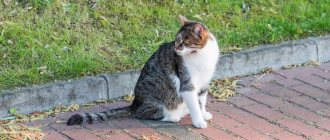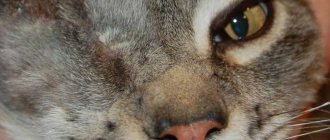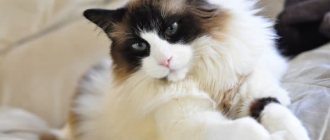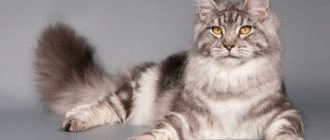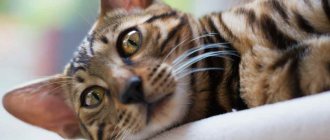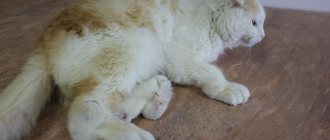“Vitality” of cats from the point of view of magic and mysticism
In the Middle Ages, people believed that cats were the main assistants of witches and sorcerers. These animals could see ghosts, and they were also ideal guides for evil forces. A cat could easily be possessed by a demon who would help the witch commit evil deeds. People also believed that witches could turn into cats. But they can only do this a few times in their entire lives. Therefore, if an unfamiliar cat appeared near the house, they always tried to drive him away immediately.
The Inquisition believed that cats were the real helpers of the devil. Therefore, these cute furry creatures were captured and killed en masse. Moreover, no attention was paid to the color of their fur, despite the fact that, according to superstition, only black cats were assistants to witches. People who tried to save animals were accused of witchcraft. Fortunately, some cats that lived at that time showed miracles of resourcefulness and somehow managed to survive.
These cute creatures are still endowed with special abilities. Esotericists claim that cats can really see what is inaccessible to human eyes: spirits, ghosts, entities. In addition, these animals are friends with brownies.
The cat and her nine lives: dismantling an old myth
Contents hide
Cats are cunning, dexterous, resourceful animals and, admittedly, lucky. They are endowed with the ability to get away with anything, even the most hopeless situation. Ancient people believed that cats were helped by higher powers. Hand on heart, we are inclined to believe it. Even in our high-tech 21st century. The myth has acquired incredible stability - we believe in it, even knowing that cats, like all of us, have only one life. And yet, let's figure it out: where did this belief come from?
That there are nine cat lives. Essentially, we mean, following our distant ancestors, the ability of cats to survive. Or the famous cat reincarnation. Here is a tailed friend traveling along the roof of a house and suddenly falls off - from the ninth floor. Death seems inevitable. But the cat miraculously regroups in flight and lands neatly on its paws. Fantastic, and that's all.
Another question. No one would dare call cats stupid and reckless animals. But, tell me, why are they so scared that they are drawn to jump out onto the roadway under the wheels of cars? And many people turn out. They know that they have several lives at their disposal. Each crossing of a busy highway means minus one life.
Let's figure out why cats have several lives. There are four theories on this matter, and we will take them as a basis.
First theory. Dexterity and resourcefulness. We just talked about this: the ability of tailed animals to survive in hopeless situations inspires admiration. Surely every cat was on the verge of death more than once, but was saved every time. Hence the theory of multiple lives.
Second theory. The deification of cats in some cultures (for example, in Ancient Egypt). The Egyptians seriously believed that cats had supernatural powers. So the theory of “nine lives” fits well with the worldview of the ancient Egyptians. A deity cannot have just one life.
Third theory. An ancient proverb, retold in different ways. The meaning of the proverb is: “A cat has nine lives. The first three she plays, the second three she wanders. And the remaining three remain with her.” There's something about it!
The fourth theory. We open a volume of Shakespeare, the play “Romeo and Juliet”. Act three, scene one. Tybalt asks: “What do you want from me?” Mercutio: “My dear cat king, I just want to take one of your nine lives...”
Choose, friends, which of the four theories is closer to you.
Why exactly nine lives? Modern researchers are inclined to believe that the answer should still be sought in Ancient Egypt. One of the legends says that the sun god Atum-Ra, having visited the underworld, took the form of a Big Cat (Mau) and gave birth to eight other deities. It turns out symbolically: nine lives in one.
Let's say more: the number 9 is iconic in many cultures and religions.
In Christianity and Hinduism, 9 symbolizes divine completeness, the triple triad. In China, 9 is considered a lucky number. In Scandinavian mythology, the Universe is divided into 9 worlds. There are only 9 muses in Greek mythology.
You will be surprised, but not in all corners of the Earth people believe that cats have 9 lives. In Spanish-speaking countries, for example, they are sure that it is “only” seven. Turks and Arabs believe that there are only six.
What is so unusual and unique about cats? Firstly, cats are excellent sprinters: when running away from pursuit, these animals can reach speeds of up to 48 km/h. True, cats are not capable of running for a long time at this pace. Secondly, cats have an incredibly flexible spine, consisting of 53 vertebrae - it allows its owners to take unimaginable poses and twist like snakes. Thirdly, cats have incredibly springy and muscular paws, allowing them to jump to a height that exceeds their own height by nine (!) times. Cats are also capable of flattening their body so much that they can squeeze through even the narrowest gap.
Myths dismantled. But what really? Alas, practice shows that cats have one life. The tailed friends break when they fall, get stuck in cracks, and die in batches under the wheels of cars. And yet cats are actually lucky. And to some extent they even have supernatural abilities. For example, what are your chances of surviving a fall from the seventh floor? But cats have them, and quite a lot of them. They will dust themselves off and move on with their business. Isn't this a miracle? All that remains is to wish our mustachioed friends less trouble and always soft landings.
Material used: Does a cat really have nine lives? Source: wamiz.co.uk Photo: pixabay.com
The lifespan of a cat according to science
Scientists do not deny the fact that cats have a certain endurance, good health and the ability to quickly recover from severe injuries. Due to the fact that these creatures can heal themselves, legends and various superstitions have appeared about them having several lives. But why do cats recover so quickly?
- Rumbling. Purring helps cats calm down and give themselves a little massage. In addition, it has been scientifically proven that rumbling helps restore damage to bone tissue, relieve inflammation and increase stress resistance.
- Sense of balance. A cat is able to land on all four paws, even if it has fallen from a great height. It's all about a good vestibular apparatus, which allows the animal to quickly group itself and take the desired body position when falling.
- Ability to quickly adapt. These animals adapt well to a wide variety of living conditions. If a domestic cat accidentally ends up on the street, then its instincts help it survive. With their help, he can always find food.
- Fast self-healing. Cat fractures heal very quickly. An animal can recover after a serious injury in just a few weeks.
Even though cats can heal themselves, they only have one life. Every owner of such a pet is well aware of this and tries to take care of its health.
Magical information
9 lives, not 10 and not 8 - in ancient times the magic nine had the following meanings. Orthodoxy notes that angels have 9 ranks. The Holy Spirit was symbolized by a star with nine points. Pluto believed that the sunken Atlantis included nine kingdoms. Bach finished the symphonies with the ninth number. The ninth wave was a terrible event for sailors.
An ancient Hindu myth tells how an “advanced cat”, a gifted mathematician, and at the same time a lazy couch potato, was half asleep at the temple entrance. Divine Shiva, passing by, asked him: “Who are you? What can you do? The cat, without opening his eyes, remarked: “I’m an old cat, I think very well.” "Perfect. And how long are you counting?” “Of course, ad infinitum.” “Do the math then.” Yawning, the cat began: “One, two, three, four.” Having counted to seven, he almost fell asleep, and when he reached nine, he began to snore. “If you only count to nine,” said Shiva, “I will give you nine lives.” Since then they say that a cat has nine lives.
The Greek gods Apollo and his sister Diana also contributed to the myth of 9 lives, so the Sun God created a calendar with a 9-month cycle, and his sister the Moon Goddess turned into a fluffy black cat. Only her amber eyes betrayed her divine essence.
The lunar year according to the calendar corresponded to the time during which the celestial body rose, was born) and set (died) nine times. Mythology has firmly connected the number nine, the cat and the Moon in people's minds. This is how a persistent belief in such a legend arose. When asked how many lives cats have, many people answer nine.
The unique ability of cats to fall on all four paws speaks of miraculous self-healing properties; the animal can break its legs, knock out teeth, receive internal injuries, even a concussion, but it will survive. A person falling from a similar height will die. That's why they say cats have nine lives. At the same time, having fallen from a low object, the cat is more injured, since it does not have time to turn around and fall on all its paws.
How many years do cats live?
Wild individuals
The lifespan of murkas directly depends on the conditions in which the animal lives. Wild tailed animals spend all their time in a difficult struggle for existence. You constantly need to conquer food, territory, bypass or engage in battle with the enemy. Such naturalistic extreme does not add years. Their life span lasts 5-8 years, and those who last up to 10-12 are long-lived.
Homeless animals
It is much more difficult for fluffies living on the street to overcome the age of 7 due to various factors.
They have to adapt to the rapidly changing conditions of city streets. Everyday dangers, lack and low quality of food found, weather vicissitudes, human cruelty, dogs - a list of problems that make the life of cats not sweet. They are only enough for 6-7 years of difficult survival. The lucky ones who are lucky enough to get into a home from the street live longer.
Pets
These luxury like gods. There are minimal dangers here, except perhaps the anger of the owner. Surrounded by care and attention, they receive healthy, nutritious food, live in warmth and kindness, behave fearlessly, are protected from many diseases by vaccinations, and receive veterinary care. In “greenhouse” conditions, the cat rarely experiences stress, so the life cycle reaches up to 15 years. Unique individuals live up to 20.
Independence, adaptability and enviable intelligence
The cat is fully endowed with these qualities. She is able to adapt to any conditions and, no matter where she lives, she manages to find warmth and food. Domestic cats, while enjoying the benefits of people, nevertheless remain independent creatures. They seem to store within themselves all the wisdom and experience of their ancestors. In addition, cats are excellent analysts who have cold prudence.
READ Structure of a cat's spine – Veterinary Network
No matter how much they talk about the 9 lives of a cat, we understand perfectly well that this is just a metaphor. Our pets have only one life during which they need to be loved and protected.
Reasons influencing the judgment of the mystical vitality of a cat
Widespread beliefs in the world about the incredible vitality of cats are not at all accidental. Like any predator, these animals have perfectly developed vision, hearing, and sense of smell. Thus, their visual acuity is six times greater than human visual acuity, while their viewing angle is almost 190°, which is one and a half times wider than that of a human.
Hearing and smell are also significantly superior to those of humans. All this, together with excellent coordination and intellectual abilities, allows the animal to notice danger in time, evade the attack of a larger predator, hide in a place inaccessible to the pursuer - in general, it greatly increases the chances of survival.
In addition, an excellent vestibular system and physique increase the chances of survival. This is especially evident when animals fall from significant heights, for example from the roof of a nine-story building, after which they often escape with only bruises. The fact is that with such a fall, the animal will always be able to twist and begin to fall with its paws down. In addition, the cat spreads out like a flying squirrel. All this, together with the light weight, slows down the fall, and the structure of the paws and their correct position at the moment of contact absorb the impact on the surface.
Did you know? Perhaps the most record-breaking fall was experienced by a kitten named Sabrina. He fell from the 32nd floor of a New York skyscraper and survived, having escaped with a missing tooth and minor injuries to his chest.
In addition, cats have developed body regeneration, which is reflected in the rapid healing of wounds. Let’s also not forget about the famous cat purr. It has long been noted that it has a beneficial effect on people, helps them relax, relieves depression, removes anxious thoughts, which ultimately has a positive effect on the condition of the human body. The rumbling has the same beneficial effect on the animal itself. It is believed that this is due to the audio range of this rumbling sound.
It is interesting to know why cats purr, why they are so afraid of water, and how many years cats live at home.
As we can see, the vitality of this animal is associated with its developed brain, natural instincts and characteristics of the body. All this was probably transformed in people's minds into the legend of the nine lives of tailed pets.
Diversity of character
Despite the seemingly complete domestication of cats, they still have an independent and freedom-loving character. Even the most notorious predators can envy their cunning and dexterity, not to mention their amazing ability to adapt to different situations. Having learned to use all the human benefits provided, they quickly adapt to their natural habitat if an urgent need arises. Even being near humans from birth, cats always live “on their own wavelength” - maybe that’s why they are credited with not one, but many lives at once.
The magic of numbers
The number nine itself is very mysterious and “multifunctional”. Since ancient times, this number has had a magical trail behind it. For example, according to Pluto, the mythical island of Atlantis consisted of 9 kingdoms or, as they would say today, states/federations/regions. In Orthodoxy, angels are divided into nine levels or, more simply put, ranks, and the symbol of the Holy Spirit is a nine-pointed star.
Nine closes the cycle of decimal, hundredth, thousandth digits of numbers - 9.19, 49, 999, etc. It also reproduces itself when multiplied by another number: 9x8=63 (6 3=9). Interesting, isn't it? What can we say about the fact that Bach’s last work was precisely the ninth symphony, and the total nightmare of all sailors is the ninth wave, immortalized in the painting of the great Aivazovsky. Well, since cats have long been attributed magical properties, it is quite logical to reward them with nine lives.
Which of the listed versions to vote for is an entirely individual choice. All of them have the right to exist, at least for their originality and unusualness.
Interesting Facts
People love their pets so much that they dedicate works of art to them:
- In recent years, cats have become cinematic heroes, helping people understand and believe in themselves. Thus, in 2021, the film “Nine Lives” was released about a workaholic billionaire who finds himself in the body of a cat bought for his daughter.
- Many in childhood read the fairy tale by Charles Perrault about the smart Puss in Boots who helped his owner. Now it delights audiences of different ages as an animated film.
The lives of these graceful animals and people have been connected for centuries, but even now cats continue to live nearby and protect us.
What will the legends tell about?
Nine Lives of a Cat
The golden era of cat history is rightfully considered the time of Ancient Egypt. They revered and worshiped the cat and tried to understand it. The goddess of love and fertility wore a cat's head. All gods were divided into 3 groups, each consisting of 9 representatives. Their creator was Ra, the sun god, who became a cat when he came to earth. He gave the animal 9 opportunities to live. In ancient Greece, the sister of the god Apollo appeared in the guise of a cat. And he himself created a calendar consisting of 9 lunar months.
According to Scandinavian mythology, these animals were in the harness of the chariot of the goddess Freya, ruler of 9 worlds.
The goddess Freya came from the myths of the Scandinavian countries. She reigned in 9 worlds, and harnessed her furry pets to her chariot. The Russian beginning of fairy tales was often the words “in a distant kingdom”, “far away lands”. This is what they say cunningly, understanding “far”. Perhaps this is where the expression about 9 lives came from, as the concept of “many”.
The dark side of history
The Inquisition cruelly mocked the fluffies. In these barbaric times, a woman with a black cat is automatically considered a witch, which means that she can turn into a cat - a messenger of the devil - 9 times, secretly enter a home and cause trouble. Poor innocent animals were persecuted, burned at the stake along with their mistresses, and walled up alive in walls.
Seven and six lives
The Arabian legend is intriguing due to its unusual nature. The life of the Messenger of Allah, the Prophet Muhammad, was saved by his beloved cat named Muetsa. As a token of gratitude, he gave the animal 6 lives. For Muslims, the number 5 is sacred; it corresponds to the number of revered human concepts - faith, prayer, mercy, pilgrimage, restrictions on fasting. However, a cat cannot be equated with people, so the prophet added one more reincarnation.
The number “seven” settled in the memory of Europeans, appearing from the literary work “The Romance of the Fox Reinecke”. In it, the titular King Tybalt was depicted as a cat with 7 lives. He was a cunning, cocky, but memorable character. During the Middle Ages, traveling troupes and minstrels roamed cities and villages, revealing their talents in staging poems and performances. This is how the fairy tale spread throughout Europe and among the wider masses.
